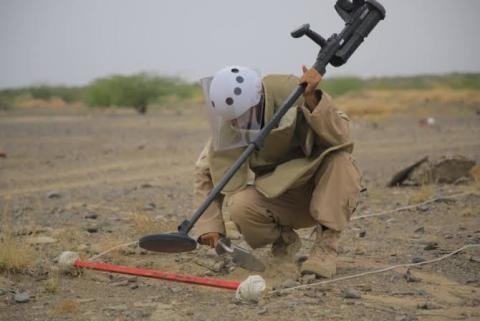UNICEF Yemen Humanitarian Situation, Report


A sharp escalation of violence characterized the month of November, with airstrikes on 1 November reportedly causing the death of six children and several other civilians in a market in Sa’ada governorate. A second airstrike on 3 November reportedly killed a family of seven people, including two children and two women. Indiscriminate shelling of residential areas in Taizz continued, reportedly killing five children.
As of 6 November, a blockade on commercial and humanitarian shipments was in effect, impacting an already catastrophic situation. This included the movement of humanitarian workers including UNICEF staff.
Fuel supplies were projected to last only until the end of the month, putting into jeopardy all humanitarian operations, as well as threatening the operation of public health facilities and public water systems. Vaccines requiring cold storage were also at risk, and current supplies would run out in under a month. Fuel prices were rising by as much as 100 per cent compared with previous monthly prices, and based on WFP estimates all diesel stockpiles would be depleted across Yemen by 2 December.
The lack of fuel would also go on to affect the Acute Watery Diarrhea (AWD)/suspected cholera response at a time when the number of new cases had been dropping steadily, threatening to reverse the containment of the outbreak.
Spiking prices put increased pressures on households, further increasing the risk of widespread food insecurity and ultimately famine. 1.25 million public sector workers have still not received their salaries for over one year, and livelihoods opportunities are vanishing. While stock levels of wheat and rice were expected to last for three more months, rapid price inflation saw the average price of a standard food basket rise by 28 per cent. More than 70 per cent of families do not have any food stored, and rely on buying what they can day to day. On 20 November, the Famine Early Warning Systems Network (FewsNET) warned that a continued blockade would expose many parts of Yemen to famine within three months.
Yemen requires monthly food imports of approximately 350,000 metric tons, of which humanitarian imports make up around 75,000 metric tons. 80 per cent of commercial and humanitarian imports normally arrive through Al Hudaydah and Saleef, and in a ‘Key Messages’ document on 13 November, OCHA noted that moving supplies through Aden or Jezan ports further south would not meet the capacity demands of 27 million civilians. UNICEF has also been concerned that this would make it more difficult to respond to a worrying outbreak of diphtheria.
After ten days of complete blockade, some sea ports in the South of the country re-opened and UNHAS flights resumed in and out of Aden. The North, however, remained blocked until an announcement on 22 November that Sana’a and Al Hudaydah would be re-opened, and on 25 November UNICEF airlifted 1.9 million lifesaving vaccines into Sana’a. The first commercial ship reached Al Hudaydah on 26 November, but after three weeks of blockade, essential commodities such as food, fuel and medical supplies had begun to run low, and by the end of the month, humanitarian organisations were still waiting for the complete lifting of the blockade.

Yemeni officials on Monday condemned arrests and prosecutions by the Iran-backed Houthi militia directed against media, journalists and celebrities…

Yemen's warring parties are gearing up for new waves of conflict in 2023 amid a lack of decisive steps towards sustainable peace, adding to the suf…

The UAE will help to recruit doctors and deliver crucial supplies for hospitals in Yemen under a major healthcare drive. The Khalifa bin…